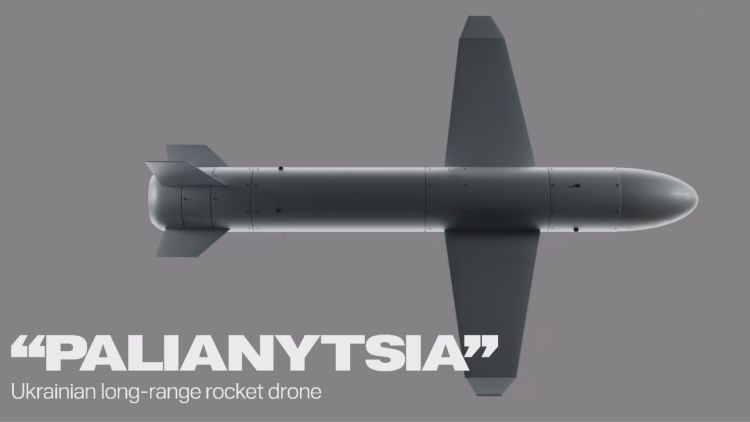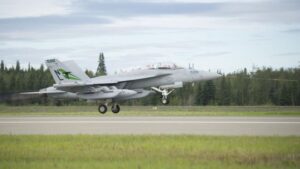After Ukraine’s bold incursion into Russia’s Kursk region on August 6, things have only intensified. As Russia steps up its long-range drone and missile attacks, Ukraine has hit back with its own new weapon: the Palianytsia rocket drone, its first long-range rocket drone.
This homegrown innovation is set to shake things up in Ukraine’s military strategy, signaling a big change from the defensive tactics Kyiv has used since the conflict started in February 2022 to a more proactive approach.
So it begs the question, what does this mean for Ukraine’s future in warfare? And can this new rocket drone really help counter Russia’s air defenses and attacks?
But first, let’s dive into what makes Ukraine’s new rocket drone, the Palianytsia rocket drone, so unique. Here’s the scoop so far.
Palianytsia Drone: Ukraine’s New Edge in Battle
Earlier this week, Ukraine introduced its newest homegrown rocket drone, named after the Ukrainian staple, Palianytsia or palyanytsia—a bread traditionally baked on a hearth and made mostly of wheat flour. This bread is a symbol of Ukrainian identity, much like apple pie is for America or Shepherd’s pie for Britain.
The name “Palianytsia” highlights that this drone is 100 percent Ukrainian-made, unlike weapons supplied by Western allies that come with restrictions on their use inside Russia.
In a social media post, President Volodymyr Zelenskyy revealed this new weapon alongside a video showing the Palianytsia drone’s ability to target more than 20 Russian air bases, suggesting it has a range of at least 370 miles.
“An absolutely new class of weapon (Palianytsia drone)… This is our new method of retaliating against the aggressor,” Zelenskyy claimed during his Independence Day speech on Sunday, August 24.
After Ukraine’s bold incursion into Russia’s Kursk region on August 6, things have only intensified. As Russia steps up its long-range drone and missile attacks, Ukraine has hit back with its own new weapon: the Palianytsia rocket drone, its first long-range rocket drone.
This homegrown innovation is set to shake things up in Ukraine’s military strategy, signaling a big change from the defensive tactics Kyiv has used since the conflict started in February 2022 to a more proactive approach.
So it begs the question, what does this mean for Ukraine’s future in warfare? And can this new rocket drone really help counter Russia’s air defenses and attacks?
But first, let’s dive into what makes Ukraine’s new rocket drone, the Palianytsia rocket drone, so unique. Here’s the scoop so far.
Palianytsia Drone: Ukraine’s New Edge in Battle
Earlier this week, Ukraine introduced its newest homegrown rocket drone, named after the Ukrainian staple, Palianytsia or palyanytsia—a bread traditionally baked on a hearth and made mostly of wheat flour. This bread is a symbol of Ukrainian identity, much like apple pie is for America or Shepherd’s pie for Britain.
The name “Palianytsia” highlights that this drone is 100 percent Ukrainian-made, unlike weapons supplied by Western allies that come with restrictions on their use inside Russia.
In a social media post, President Volodymyr Zelenskyy revealed this new weapon alongside a video showing the Palianytsia drone’s ability to target more than 20 Russian air bases, suggesting it has a range of at least 370 miles.
“An absolutely new class of weapon (Palianytsia drone)… This is our new method of retaliating against the aggressor,” Zelenskyy claimed during his Independence Day speech on Sunday, August 24.
While this is shorter than some of Ukraine’s existing long-range attack drones, which can reach over 1,000 miles, it’s still a significant capability.
Ukraine’s defense sector is bustling with small companies producing a wide range of attack drones—analyst HI Sutton has documented around 24 types.
(HI Sutton Blog)
Cost-Effective and Powerful: Palianytsia’s Operational Advantage
The Palianytsia drone seems to fit a unique role within this diverse arsenal.
Equipped with a micro-turbojet engine that generates 95 pounds of thrust, the Palianytsia combines the agility and adaptability of a drone with the destructive power of a missile.
It’s reportedly equipped with a 20-kilogram (44-pound) blast fragmentation warhead, similar to what’s found in an AIM-120 AMRAAM missile.
The rocket drone has a classic rocket shape with a central body, wings up front, and a detachable tail section.
It can be launched from a ground platform and is said to be more cost-effective to operate than other weapons of its kind.
According to reports, Ukrainian forces intend to use the Palianytsia drone to strike against Russian aircraft on the ground before they can launch their own attacks.
This strategy, which experts call “killing the archer, not the arrows,” focuses on taking out threats at their source, giving Ukraine a big tactical edge in the ongoing conflict.
Further technical specifications of the rocket drone remain classified for obvious reasons.
Still, its design alone suggests it is built for high-speed strikes, which is ideal for hitting moving or temporarily stationary targets like aircraft.
Insider Insight on Ukrainian Rocket Drone’s Development
In an interview with UNITED24 Media, a specialist who has insider insight into the Palianytsia drone said that the development took about a year and a half and involved a large team of experts from various fields.
“We developed it (Palianytsia drone) entirely from scratch, not continuing any old Soviet projects,” the specialist, under the condition of anonymity, recounted.
The specialist proceeds to explain the challenges of developing a cruise missile, which is one of the reasons the development of the Palianytsia drone took so long.
“Even for simple products, the mechanical design can take months, involving countless calculations to ensure every component can withstand the necessary loads,” they explained. “There are hundreds of details and considerations for how these parts will function together.”
They remained vague about its specifics and the number of rocket drones they have so far managed to mass-produce.
“For security reasons, I can’t disclose how many rocket drones we’ll produce monthly, but it will be a significant number,” they added.
When asked why President Zelenskyy called the new weapon a “rocket drone,” the specialist broke it down, without disclosing too much of its details, to speed and firepower.
“A missile often carries a larger warhead, leading to greater destruction. These are two key features that set the Palianytsia apart from the drones Ukraine is already familiar with,” they told UNITED24 Media.
Ukraine has used its experience with long-range drones to bring some of that tech into this latest DIY weapon, showing that both drones and cruise missiles are just different types of unmanned aircraft.
Illustrative image of Palianytsia rocket drone. (UNITED24 Media)
While the exact cost of the rocket drone can’t be shared, the goal, according to the specialist, is to make it affordable and easy to mass-produce.
Unlike expensive missiles that can cost millions and be lost if shot down, cheaper drones like the Palianytsia can be launched in large numbers, making it harder for the enemy to defend against them.
“The cost of Palianytsia is well below $1 million,” they said, and efforts are ongoing to lower this cost even more, including producing parts locally.
“Our ultimate goal, as mentioned, is to produce as many missiles as possible to cripple the enemy’s offensive capabilities on their territory,” they added.
As Ukraine continues to innovate with tools like the Palianytsia drone, it’s clear that its approach to modern warfare is evolving rapidly. To learn more about this groundbreaking technology, check out the full interview here.
Recap and Final Thoughts
So, what does all this mean for Ukraine’s future in the fight?
The unveiling and deployment of the Palianytsia rocket drone show a big shift in Ukraine’s approach, moving from mostly playing defense to taking the fight directly to the enemy. This new drone lets Ukraine hit important Russian targets before they even get a chance to launch their own attacks, putting Ukraine on the offensive for a change.
With its blend of speed, firepower, and lower cost, the Palianytsia drone could give Ukraine a real edge. Because they are cheaper to make than traditional missiles, Ukraine can produce them in large numbers to overwhelm Russia’s air defenses. This idea of “taking out the archer, not the arrows” could be a smart way to cut off attacks at their source and throw a wrench in Russia’s plans.
In short, the Palianytsia drone might just change the game for Ukraine. It marks a move towards relying more on their own tech and shifting strategies that could really change the conflict’s dynamics.
As Ukraine continues to push the envelope and innovate, tools like the Palianytsia could be key in beating back Russian air attacks and reshaping its military future.
Do you think Ukraine’s shift to indigenous technology will change the course of the conflict? Share your thoughts in the comments below!
—
Disclaimer: SOFREP utilizes AI for image generation and article research. Occasionally, it’s like handing a chimpanzee the keys to your liquor cabinet. It’s not always perfect and if a mistake is made, we own up to it full stop. In a world where information comes at us in tidal waves, it is an important tool that helps us sift through the brass for live rounds.



